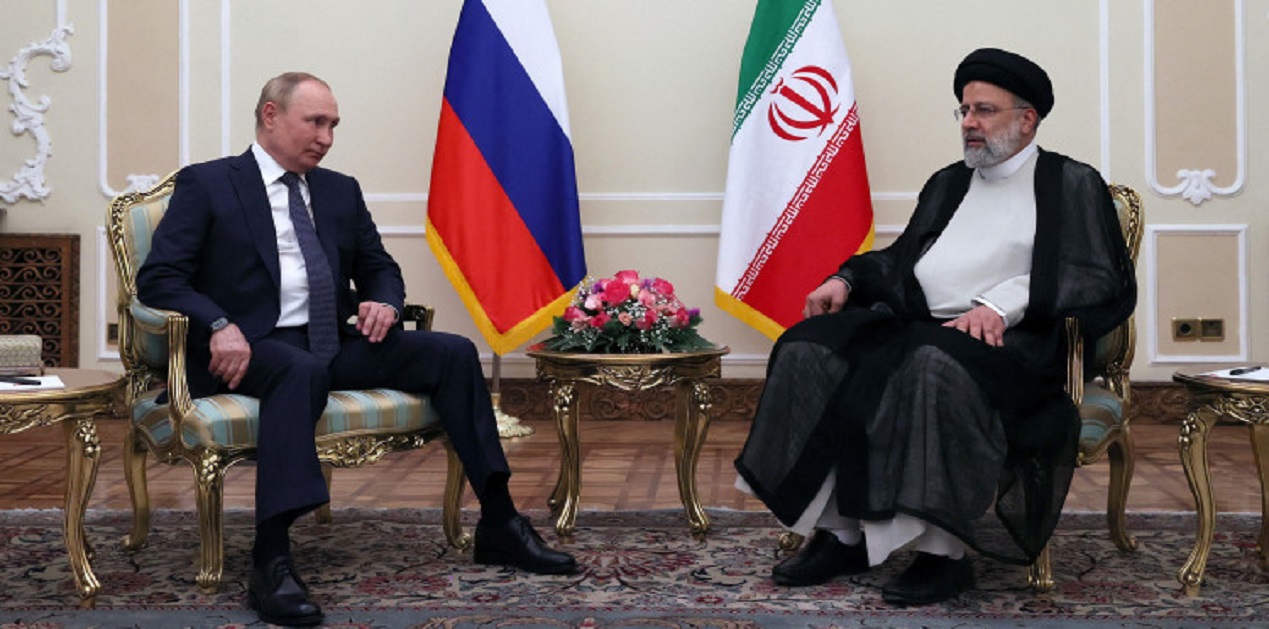After deciding to invade Ukraine in February 2022, Russia has been subject to financial, economic, diplomatic, military, and even sports sanctions by numerous countries and international organizations. Sanctions have been used for decades as a punitive measure on state and non-state actors for various activities such as the violation of international treaties, and arms proliferation. Iraq was sanctioned by the United Nations in August 1990 for its invasion of Kuwait. Notably, the United States Department of State sanctioned the Russian government in August 2002, under the ‘Sanctions for the Transfer of Lethal Military Equipment’ Act for providing “lethal military equipment” to a state accused of sponsoring terrorism.[1] Despite such punitive measures, states have managed to circumvent the sanctions by employing various tactics including cooperation with other like-minded states to deal with the problem. A case in point, Russia could learn from other states sanctioned in the past, such as Iran.
Russia, as of February 2022, is the world’s most sanctioned state, with a total of 14,081 sanctions on their companies, institutions, and individuals. Iran, prior to Russia’s actions in Ukraine was the most sanctioned state globally - with 3,616 sanctions, which were further hiked to 4,191 post–February 2022, Russia – Ukraine conflict.[2] Russia faced its first sanction regime after the annexation of Crimea in 2014. The United States (US) and the European Union (EU), in addition to the export embargos restricted Russian access to the financial markets of the west in the sectors of banking and energy. This impacted the Russian economy adversely with a negative GDP rate in the first quarter of 2015. In the light of this, Moscow was prepared for the first incoming wave of sanctions in 2022. The economy of Russia, despite being subject to these measures, only contracted by 2.1 percent in 2021 suggesting stabilization after the initial round of sanctions. Russia has learned how to navigate sanctions and adopted mitigatory measures. It softened the initial hit of the sanctions wave by stashing up gold, reserves, and other assets. These gold reserves and foreign assets amounted to US$ 630 billion, the fifth largest pile in the world. Although Russia lost access to its foreign reserves, it could still utilize the gold reserves it had stored in banks in the country.
Russia has been adept at paying off its international loans to wean itself off foreign capital. Russia is a net creditor on the international market, with loans amounting to US$ 39 billion in 2021 and its overall national debt adding up to just 17 percent of its GDP.[3] In contrast, the national debt of the USA is approximately 130 percent of its GDP.[4] Moreover, to incentivize its domestic populace to keep their money in banks and to protect their savings from depreciation, the Russian central bank hiked the interest rate from 9.5 percent to 20 percent. Furthermore, the country could engage in economic self-sufficiency as it was quick to replace the withdrawing industries and markets with domestic substitutes. Besides this, the country is also a major producer of wheat, oil, natural gas, and metals like palladium and nickel. These measures helped stabilize the rouble by June 2022.[5],[6]
Moscow also sought to capitalize on Europe’s demand for energy. Notably, around 40 percent of Europe’s energy requirement is provided by Russia. The EU banned several Russian banks from the Society for Worldwide Interbank Financial Telecommunications (SWIFT) messaging system but spared those involved in energy payments and exports, like Gazprombank and Sberbank.[7] The European states were also forced to comply with a new billing system that would process gas payments and invoices in euros. However, Russia could convert this to roubles thereby helping to stabilize their currency.[8] Notably, the ban on Russian oil exports happened in delayed phases that is the ban for Russian seaborne crude oil happened in December 2022 whereas the ban for diesel and other refined products came into effect in February 2023. Therefore, the west placed a price cap of US$ 60 per barrel, which can be viewed as an indirect permit for trade with reduced prices. [9],[10]
Russia also benefitted from the differences among the EU member states. A few countries within the EU have interests that needed Russian assistance and sought to block or delay movements within the EU that were against Russia. This was critical as the sanctions packages of the EU require consensus. For instance, in April 2022, Greece, Cyprus, and Malta blocked a movement aiming to ban all Russian ships and those with Russian interests. In September 2022, Hungary called for removing the names of three Russian oligarchs off the individual sanctions list but has since dropped this demand. Furthermore, Belgium continued their diamond trade with Russia albeit in much-reduced quantities.[11]
One factor that served as a blow to Russia’s plans was the failure of General Winter. Europe faced one of its warmest winters on record and states such as Denmark, Poland, Netherlands, and Germany noted record-high temperatures.[12] Europe has also begun to diversify its energy sources, prompting Russia to resort to hiking trade with other states. Turkey emerged as a trans-shipment hub for imports into Russia, such as tech goods and parts. Notably, Iran has emerged as a critical partner for Russia during the current period.[13]
The first set of sanctions was imposed on Iran following the 1979 hostage crisis and the latest round was imposed in January 2023 to target the sale of Iranian drones to Russia to employ against Ukraine. The sanctioning entities such as the US and the EU have targeted individuals for human rights violations as well as global firms involved in ‘illegal’ oil and petrochemical trade with Iran. Both Iran and Russia have been forced to resort to alternate or domestic substitutes for their economic necessities and to fill in the gaps in the supply chain.[14] Russian President, Vladimir Putin and Iranian President, Ebrahim Raisi during the latter’s two day visit to Moscow in 2022, emphasised the necessity of their relations against US unilateralism.[15] The two countries benefit from their mutual trade amounting to US$ 4.9 million in 2022. These presidential meetings led to agreements regarding Russian investments in Iran’s oil and gas sector and Iranian spare parts for aircrafts and motor vehicles. Gazprom for instance, agreed to invest US$ 40 billion in Iran’s oil and gas sector. According to Ukrainian President, Volodymyr Zelenskyy, more than 80 Iranian drones which were launched by the Russian military were shot down in Ukraine. This is an indicator that ties are improving and the two countries, purged by sanctions, are keenly developing extensive trading networks and supply chains independent of the western route.[16]
According to the Russian transport minister Vitaly Savelyev, his country has been studying the case of Iran and its ability to evade sanctions. Russia has sought to take a page out of Iran’s book when it comes to evading oil sanctions.[17] Iran has managed to circumvent these sanctions by employing ship-to-ship transfers and blending them with other foreign crude oil to disguise its origin. Russia has employed the same by mixing 49.99 per cent of its oil with others, calling it the Latvian blend. They also use the tactic of ‘ghosting’, that is, to turn off their auto-identification systems when transferring the barrels across ships. Moscow would look towards Iran to replicate Iran’s financial architecture devoid of western sanctions.[18] According to a report by a Russian news agency, Vedomosti, in January 2023 Moscow and Tehran were reportedly in talks to launch a joint cryptocurrency backed by gold which would help bypass sanctions and could be used in their bilateral trade deals. There are benefits and detriments to this method. Both states have banned the use of cryptocurrency within their territory but are working to establish crypto payments with each other and facilitate foreign trade. The longevity of the cryptocurrency however, depends on its acceptance, which is complicated to obtain for both states. The setup of a platform for exchanging the said currency could also face difficulty. Therefore, although cryptocurrencies can help both the states in trade, they may not be as effective in the long term to avoid sanctions and they would have to devise new methods.[19]
On 7 February 2023, both states signed an agreement formally linking their interbank transfer systems, connecting 52 Iranian banks operating with Iran’s telecom system, SEPAM, with 106 banks operating with that of Russia, SPFS.[20] Russia also seeks to expand this network by incorporating other big economies, such as China and India. China and India are both vital states for Russia and Iran for distinct reasons. The former serves as a vital industry for semiconductors and other tech parts whereas the latter is an important trade and transit partner. In February 2023, Chinese President, Xi Jinping during his meeting with his Iranian counterpart, Raisi and called for lifting of sanctions imposed on Iran. India is a strategic partner for Russia as it has largely remained isolated from the sanctions imposed by the west and others.[21] Both Russia and Iran are keen to establish trade routes with India to bypass sanctions. The International North South Transport Corridor (INSTC), connecting Iran to Russia via India and Azerbaijan, bypassing the Suez Canal is an effort towards circumventing these sanctions. This is essential to Moscow as it is eager to establish trade routes evading western lines. While Tehran and Moscow plan an ambitious investment in the INSTC, the piling sanctions might make it difficult for both states to proceed with the project.[22]
One of the major highlights concerning the growing relationship between Russia and Iran amidst rising sanctions is the stalled Vienna talks. Since the derailment in the Joint Comprehensive Plan of Action (JCPOA) negotiations, good ties between the two are more essential than ever. The bilateral relationship also impacts other states similarly impacted by sanctions, such as Syria. The Office of Foreign Assets Control of the Treasury Department of the US identified an international network where the Iranian regime works with Russia to supply oil barrels to Syria. The Syrian government in turn facilitates the movement of finances to the Revolutionary Guard Corps to fund Hamas and Hezbollah.[23] Similarly, Russia and Iran could also engage in competition in Syria for greater influence on oil and port construction contracts in which Russian companies would be preferred.
The relationship between Russia and Iran also calls the effectiveness of sanctions into question. Both states have managed to survive despite these punitive measures and cooperating with similarly affected countries has helped alleviate their issues. Sanctions are more of a long-term measure as countries tend to prepare for them beforehand. Therefore, the full impact of the sanctions is yet to be felt by Russia. Interestingly, one success story for the implementation of sanctions is that of Iran itself, where it conceded to sit at the bargaining table to negotiate the Iran Nuclear Deal in 2015 due to the crippling impact of sanctions on its economy. However, when the United States, under the Donald Trump administration, withdrew from the deal in 2018, it imposed even stricter sanctions on Iran. Therefore, both states have learned to navigate sanctions and these measures will only push the two closer to each other.
Conclusion
New set of sanctions were imposed by the US and its allies on Russia as well as Iran in the wake of the Russia-Ukraine conflict. Due to its previous experience with the sanction regime, Russia was prepared for the same and hence was able to quickly stabilise its economy. Russia resorted to stashing up gold, clearing off loans, spiking interest rates to balance out the negative impact of sanctions on the Russian economy. Europe’s dependency on Russia for energy further benefited Russia economically. Notably, the sanctions have opened new avenues for similarly affected countries to engage and cooperate. Moscow and Tehran have stressed on the significance of strengthening bilateral engagement. A boost to bilateral trade, frequent diplomatic visits, and linking of banking systems are all efforts towards enhancing the same. The effectiveness of these sanctions is still up for debate. The sanctions have however, been counter-effective in terms of their implementation and may intensify closer geopolitical and geo-economic engagement among the affected states.
Endnotes
[1]US Department of State, “Ukraine and Russia Sanctions”, US Department of State, at https://www.state.gov/ukraine-and-russia-sanctions/ (Accessed June 27, 2023).
[2]F. Zandt, “The World’s Most-Sanctioned Countries”, Statista, February 22, 2023, at Chart: The World's Most-Sanctioned Countries | Statista (Accessed March 01, 2023).
[3]H. Robertson, “Russia is Back on the Brink of A Debt Default After the US Blocked its Dollar Payments”, Markets Insider, April 5, 2022, at Russia Is Back on the Brink of Default. Here's What Happens Next. (businessinsider.com) (Accessed March 07, 2023).
[4]Trading Economics, “United States Gross Federal Debt to GDP”, Trading Economics, 2022, at United States Gross Federal Debt to GDP - 2022 Data - 2023 Forecast (tradingeconomics.com) (Accessed March 07, 2023).
[5]Reuters, “Russian Central Bank Hikes Rate to 20% in Emergency Move, Tells Firms to Sell FX”, Reuters, February 28, 2022, at Russian central bank hikes rate to 20% in emergency move, tells firms to sell FX | Reuters (Accessed March 07, 2023).
[6]T. Huileng, “It’s No Surprise Russia is Weathering the West’s Sanctions: Putin has been Preparing for them for Nearly a Decade”, Insider, June 18, 2022, at Putin Has Been Preparing for Western-Led Sanctions for Nearly a Decade (businessinsider.com) (Accessed March 08, 2023).
[7]P. Blenkinsop, “EU Bars 7 Russian Banks from SWIFT, but Spares Those in Energy”, Reuters, March 03, 2022, at EU bars 7 Russian banks from SWIFT, but spares those in energy | Reuters (Accessed March 08, 2023).
[8]C. Harlan & S. Pitrelli, “Europe Accepts Putin’s Demands on Gas Payments to Avoid More Shut-offs”, The Washington Post, May 24, 2022, at Europe accepts Putin’s ruble payment system to avoid gas cutoffs - The Washington Post (Accessed March 11, 2023).
[9]The Economist, “How Russia Dodges Oil Sanctions on an Industrial Scale”, The Economist, January 29, 2023, at How Russia dodges oil sanctions on an industrial scale (economist.com) (Accessed March 11, 2023).
[10]World Economic Forum, “EU’s Ban on Russian oil Products”, World Economic Forum, February 07, 2023, at The EU has banned Russian oil products, here's why | World Economic Forum (weforum.org) (Accessed March 11, 2023).
[11]J. Rankin, “Belgium’s Trade in Russian Diamonds Continues Despite Moral Pressure”, The Guardian, November 20, 2022, at Belgium’s trade in Russian diamonds continues despite moral pressure | Belgium | The Guardian (Accessed March 11, 2023).
[12]I. Livingston, “Thousands of Records Shattered in Historic Winter Warm Spell in Europe”, The Washington Post, January 02, 2023, at Thousands of records shattered in historic winter warm spell in Europe - The Washington Post (Accessed March 11, 2023).
[13]A. Prokopenko, “Russia’s Return to Grain Deal is a Sign of Turkey’s Growing Influence”, Carnegie Politika, November 08, 2022, at Russia’s Return to Grain Deal Is a Sign of Turkey’s Growing Influence - Carnegie Endowment for International Peace (Accessed March 11, 2023).
[14]A. Macias, “U.S. Slaps Iran with Another Round of Sanctions Over Drones Used in Russia’s War on Ukraine”, CNBC, January 06, 2023 at U.S. sanctions Iran over drones used in Russia's war on Ukraine (cnbc.com) (Accessed March 01, 2023).
[15]M. Motamedi, “Putin and Raisi Back Closer Ties in Kremlin Meeting”, Aljazeera, January 19, 2022, at Putin and Raisi back closer ties in Kremlin meeting | Vladimir Putin News | Al Jazeera (Accessed March 12, 2023).
[16]N. Smagin, “Comrades – In – Sanctions: Can Iran Help Russia Weather the Economic Storm?”, Carnegie Politika, November 04, 2022, at Comrades-in-Sanctions: Can Iran Help Russia Weather the Economic Storm? - Carnegie Endowment for International Peace (Accessed March 12, 2023).
[17]TASS, “Minister Reveals how many Planes Were Transferred to Russian Aeronautical Register”, TASS, March 22, 2022, at Minister reveals how many planes were transferred to Russian aeronautical register - Business & Economy - TASS (Accessed March 18, 2023).
[18]N. Ebrahim, “If Russia Wants to Evade Sanctions, It Could Learn from Iran’s Playbook”, CNN, April 15, 2022, at If Russia wants to evade sanctions, it could learn from Iran's playbook | CNN Business (Accessed March 15, 2023).
[19]D. Dudley, “Russia and Iran Eye Up Trade Using Crypto Currencies to Avoid Dollars and Sanctions”, Forbes, January 18, 2023, at Russia And Iran Eye Up Trade Using Cryptocurrencies To Avoid Dollars And Sanctions (forbes.com) (Accessed March 15, 2023).
[20]M. Motamedi, “Iran and Russia’s Efforts to Link Banking Systems?”, Aljazeera, February 08, 2023, at What’s behind Iran and Russia’s efforts to link banking systems? | Banks News | Al Jazeera (Accessed March 11, 2023).
[21]Aljazeera, “China Calls for Iran Sanctions to be Lifted During Raisi’s Visit”, Aljazeera, February 16, 2023, at China calls for Iran sanctions to be lifted during Raisi’s visit | News | Al Jazeera (Accessed March 15, 2023).
[22]N. Mikovic, “A Russia-Iran Trade Corridor to Nowhere”, The Arab Weekly, January 17, 2023, at A Russia-Iran trade corridor to nowhere | Nikola Mikovic | AW (thearabweekly.com) (Accessed March 22, 2023).
[23]US Department of State, “Treasury Designates Illicit Russia-Iran Oil Network Supporting the Assad Regime, Hizballah, and HAMAS”, U.S. Virtual Embassy Iran, November 20, 2018, at Treasury Designates Illicit Russia-Iran Oil Network Supporting the Assad Regime, Hizballah, and HAMAS - U.S. Virtual Embassy Iran (usembassy.gov) (Accessed March 22, 2023).
(The paper is the author’s individual scholastic articulation. The author certifies that the article/paper is original in content, unpublished and it has not been submitted for publication/web upload elsewhere, and that the facts and figures quoted are duly referenced, as needed, and are believed to be correct). (The paper does not necessarily represent the organisational stance... More >>
Image Source: https://www.mei.edu/sites/default/files/styles/featured_image_article/public/2022-08/GettyImages-1241994290_edited.jpg?itok=h0bElEJs











Post new comment